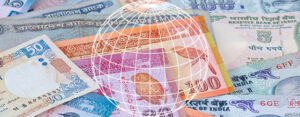Internationalization of Rupee
(Relevant for General Studies Paper Prelims/Mains)

- The rupee serves as the official currency of India, which boasts the world’s fifth-largest economy in terms of nominal GDP and the third largest in terms of purchasing power parity. Additionally, the rupee is recognized as legal tender in neighboring countries like Bhutan and Nepal. Despite these aspects, the rupee has not achieved the status of a global currency, as its presence in the international foreign exchange market and trade transactions remains quite limited.
- The internationalization of the rupee pertains to the process of expanding the utilization and acceptance of the currency beyond India’s borders, encompassing its use in trade, investments, reserves, and other areas. Promoting the internationalization of the rupee can yield numerous advantages for India. However, this endeavor also presents several challenges and risks that need to be considered.
Current Status for the Rupee’s Internationalization
- The process of internationalizing the rupee is still in its early stages, as the rupee’s daily average share in the global foreign exchange market stands at around 1.6%. Additionally, India’s share in global goods trade remains relatively low at only 2%.
- India has taken certain measures to promote the internationalization of the rupee, such as allowing external commercial borrowings in rupees and encouraging Indian banks to establish Rupee Vostro accounts for banks from countries like Russia, the UAE, Sri Lanka, and Mauritius. Efforts have also been made to facilitate trade with approximately 18 countries using the rupee as the transaction currency.
- However, the adoption of such measures has been limited, as India continues to purchase oil from Russia using dollars, highlighting the challenges faced in fully internationalizing the rupee. It is crucial to address the concerns expressed by India’s neighboring countries to ensure the smooth progress of the rupee’s internationalization.
- Furthermore, the demonetization policy implemented in 2016 shook confidence in the Indian rupee, particularly in Bhutan and Nepal. Both countries still harbor apprehensions regarding potential future policy changes by the Reserve Bank of India, including the possibility of further demonetization. Additionally, the recent decision to withdraw the ₹2,000 note in 2023 has also had an impact on confidence in the rupee.
Benefits of Internationalising the Rupee
- The internationalization of the rupee holds the potential to reduce India’s reliance on foreign currencies, such as the US dollar, for international trade and financial transactions. By embracing the internationalization of the rupee, India can enhance its economic sovereignty and decrease vulnerability to currency fluctuations.
- One of the key advantages of rupee internationalization is the facilitation of smoother international trade. Direct transactions in rupees would eliminate the need for currency conversions, resulting in reduced transaction costs and simplified cross-border trade.
- Furthermore, a globally recognized and widely used rupee would attract foreign investors and stimulate capital inflows. This, in turn, would create greater investment opportunities and enhance liquidity in the Indian financial markets.
- The internationalization process also brings benefits to India’s monetary policy. With an expanded international presence, the Reserve Bank of India (RBI) can utilize the exchange rate as a tool to manage inflation and stimulate economic growth. This flexibility enables the RBI to effectively navigate monetary conditions and respond to economic challenges.
- As the rupee gains acceptance on the international stage, financial services tied to rupee-denominated transactions, such as trade financing, currency hedging, and settlement services, would experience growth. This growth would contribute to the development of a robust and competitive financial services sector within India.
Challenges of Internationalizing the Rupee
- The internationalization of the rupee introduces the rupee to increased exchange rate volatility, which can have implications for trade competitiveness, foreign investment flows, and the stability of financial markets. It becomes essential to effectively manage exchange rate risks to minimize potential negative impacts.
- When the rupee is opened up to international markets, there is a risk of capital flight if investors lose faith in the currency or anticipate unfavorable economic conditions. This can put pressure on the country’s foreign exchange reserves, impact financial stability, and pose challenges for the management of monetary policy.
- Furthermore, the rupee faces stiff competition from well-established international currencies like the US dollar, euro, and yen, which enjoy wide acceptance and high liquidity. Gaining market share and displacing these dominant currencies represents a significant challenge.
- To encourage market participants, including businesses, individuals, and financial institutions, to adopt the rupee for international transactions, it is crucial to build trust, familiarity, and confidence in the currency. Raising awareness about the advantages of using the rupee globally is a considerable undertaking.
Specific Reforms that India can Pursue to Internationalize the Rupee
- By aiming for complete convertibility by 2060, India seeks to enable unrestricted movement of financial investments between the country and other nations. This initiative would facilitate seamless buying and selling of the rupee by foreign investors, thereby increasing its liquidity and overall appeal.
- In addition to this, establishing agreements with countries like Sri Lanka would enable India to conduct trade and investment transactions using the rupee, eliminating the need to rely on reserve currencies such as the dollar.
- To maintain confidence in the currency, it is important to avoid abrupt and drastic changes like devaluation or demonetization, as these can have a significant impact on trust and belief in the rupee.
- Furthermore, ensuring a consistent and predictable issuance and retrieval of notes and coins is crucial to provide stability and reliability in the currency system.
To master these intricacies and fare well in the Sociology Optional Syllabus, aspiring sociologists might benefit from guidance by the Best Sociology Optional Teacher and participation in the Best Sociology Optional Coaching. These avenues provide comprehensive assistance, ensuring a solid understanding of sociology’s diverse methodologies and techniques.
Indian Rupee, Internationalization, Currency, Foreign Exchange, International Trade, Economic Sovereignty, Demonetization, Global Currency, Financial Markets, Reserve Bank of India, Monetary Policy, Convertibility, Best Sociology Optional Teacher, Best Sociology Optional Coaching, Sociology Optional Syllabus.
Follow us :
🔎 https://www.instagram.com/triumphias
🔎https://www.youtube.com/c/TriumphIAS
https://t.me/VikashRanjanSociology
Find More Blogs
|
Scope of the subject and comparison with other social sciences |
|||
|
|
|
|
Modernity and social changes in Europe |


